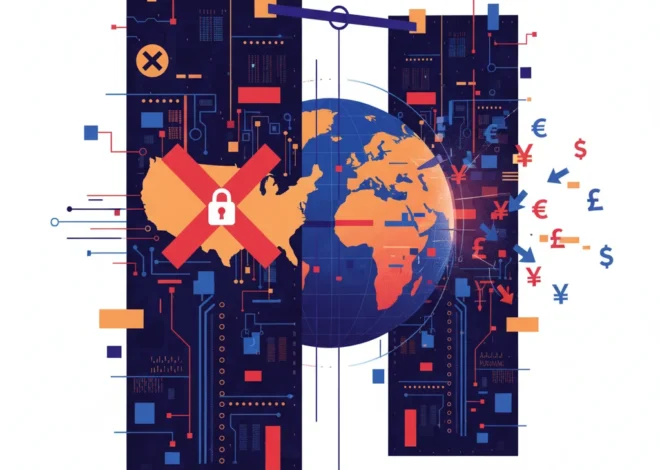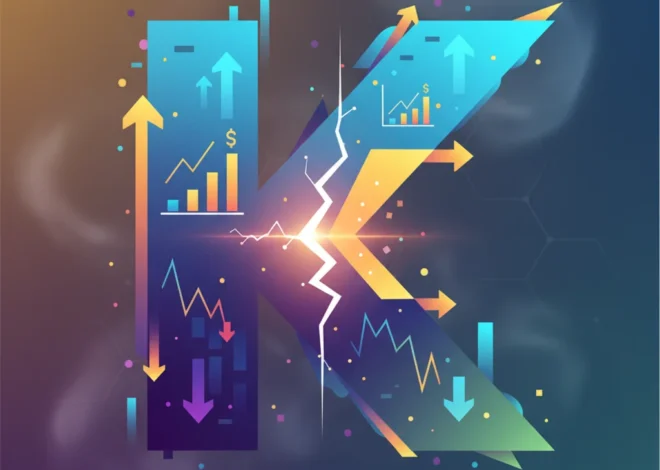
The Prime Factor of Risk: What a Simple Numbers Puzzle Reveals About the Stock Market
In the world of finance and investing, we are obsessed with factors. We build intricate models based on interest rates, earnings growth, inflation data, and countless other variables. We believe that if we can just account for every component, we can predict, and therefore control, the outcome. But what about the factors we can’t see? What about the risks that exist just outside our carefully constructed systems?
A deceptively simple puzzle recently published by the Financial Times offers a profound metaphor for this very challenge. The question was:
“What is the smallest positive integer that is not a factor of 25! (factorial 25)?”
At first glance, it’s a mere mathematical curiosity. But for anyone involved in the economy, from a seasoned investor to a fintech innovator, the solution holds a critical lesson about risk, foresight, and the very nature of our financial systems. It teaches us that the most significant threats often aren’t complex derivatives of the factors we already know, but something far more fundamental that lies just beyond our field of vision.
Understanding the “Factorial World” of Finance
First, let’s deconstruct the puzzle. The term “25!” or “factorial 25” represents the product of all positive integers from 1 up to 25 (1 x 2 x 3 x … x 25). This is an immense number, but its composition is straightforward. It contains every integer up to 25 and all their possible combinations as factors. Any composite number less than or equal to 25, like 10 (2×5) or 24 (2x3x4), is by definition a factor of 25!.
Think of 25! as a proxy for a sophisticated financial model or the entire known stock market. It represents a closed system built on a defined set of variables:
- Historical price data
- Corporate earnings reports
- Economic indicators (GDP, CPI, unemployment)
- Established correlations between asset classes
- Interest rate policies from central banking institutions
Within this “factorial world,” we are comfortable. Our quantitative analysts, trading algorithms, and risk management systems are designed to operate here. They can slice and dice the known factors in infinite ways, calculating volatility, beta, and standard deviation. This is the world of predictable risk, the kind we can model, hedge, and price into our investment strategies. It’s the realm of business-as-usual, where the rules are understood and the components are all on the table.
The Hunt for “29”: Identifying Prime Risks
The puzzle’s solution reveals the flaw in relying solely on this closed system. The smallest positive integer that is not a factor of 25! is 29.
Why? Because 25! contains all the prime numbers up to 25 (2, 3, 5, 7, 11, 13, 17, 19, 23) and all the composite numbers that can be built from them. The first number that cannot be constructed from these building blocks is the very next prime number: 29. It is an indivisible, fundamental component that exists entirely outside the original set.
In the world of finance, “29” is a Prime Risk. It is a fundamental, game-changing event that is not a derivative of the known variables in our models. It’s an event that our historical data, our “factorial,” gives us no way to predict. This concept is famously known as a “Black Swan,” a term popularized by Nassim Nicholas Taleb to describe rare, high-impact, and retrospectively predictable events. As Taleb noted, “The inability to predict outliers implies the inability to predict the course of history.” (source).
History is littered with these “Prime Risk” events:
- The 2008 Financial Crisis: Models assumed housing prices in different regions were uncorrelated. The “Prime Risk” was the hidden, systemic correlation that brought the global banking system to its knees.
- The COVID-19 Pandemic: Economic models accounted for regional health crises, but not a global pandemic that would simultaneously halt supply chains, cripple service economies, and trigger unprecedented government intervention.
- The Rise of Fintech: Traditional banking models understood competition from other banks. They did not factor in the “Prime Risk” of decentralized finance (DeFi) and agile financial technology startups completely rewriting the rules of lending, payments, and investing.
The following table illustrates the crucial difference between operating within the known system and accounting for these external, fundamental risks.
| Concept | “Factorial” Thinking (Managing Knowns) | “Prime Risk” Thinking (Searching for Unknowns) |
|---|---|---|
| Data Source | Historical stock market data, past earnings | Geopolitical trends, technological disruption, climate science |
| Risk Model | Value at Risk (VaR), Standard Deviation | Scenario Analysis, Stress Testing for “unthinkable” events |
| Mindset | “How can we optimize based on past performance?” | “What fundamental assumption could be wrong?” |
| Example | Adjusting a portfolio for interest rate sensitivity | Hedging against a systemic failure of the power grid |
Most of our time and resources in finance are spent on “Factorial Thinking.” This is necessary for day-to-day operations, but it’s “Prime Risk Thinking” that ensures long-term survival and uncovers generational opportunities.
The Scottish Rental Crisis: A Canary in the Coal Mine for the UK Economy?
From Metaphor to Reality: Prime Numbers in Modern Finance
While the puzzle serves as a powerful metaphor, the importance of prime numbers in finance is also literal and profound. The security of the modern global economy is built upon their unique mathematical properties.
The core of modern cryptography, particularly RSA (Rivest–Shamir–Adleman) encryption, relies on the simple fact that it is computationally easy to multiply two large prime numbers together, but extraordinarily difficult to take that product and find the original two prime factors. A 2020 study highlighted that even with advanced techniques, factoring a 250-digit number took thousands of core-years of computing time (source). This asymmetry is what protects your financial data.
Here’s where it becomes critical to our industry:
- Secure Banking and Trading: Every time you log into your online banking portal, execute a trade on the stock market, or use a credit card, RSA encryption is working in the background. It uses a public key (the product of two huge primes) to encrypt data and a private key (the primes themselves) to decrypt it. Without the computational difficulty of prime factorization, our entire digital financial infrastructure would be vulnerable.
- Blockchain and Cryptocurrency: The security of technologies like Bitcoin and Ethereum hinges on cryptographic principles. Elliptic Curve Digital Signature Algorithm (ECDSA), which secures transactions, relies on the difficulty of certain mathematical problems that are related to prime fields. The integrity of the blockchain, a cornerstone of modern fintech, is therefore intrinsically linked to the power of prime numbers.
- Financial Technology Innovation: As fintech companies develop new ways to handle transactions and manage assets, the need for robust security only grows. The development of quantum computing poses a long-term threat to current encryption standards, prompting a race to develop new, quantum-resistant cryptographic methods, many of which continue to explore the deep properties of number theory.
How to Find Your “29”: A Guide for Investors and Leaders
Understanding the “Prime Risk” concept is one thing; applying it to your investment strategy or business leadership is another. How can we train ourselves to look beyond the comfortable confines of our factorial models?
1. Redefine Diversification
Traditional diversification means spreading investments across different stocks, bonds, and sectors. True diversification, inspired by “Prime Risk” thinking, involves hedging against systemic shocks. This could mean allocating a small portion of a portfolio to assets that perform well in chaos, like long-volatility options, certain commodities, or strategies that are fundamentally uncorrelated with the broader economy.
2. Stress-Test for the Impossible
Don’t just back-test your strategies against past downturns. Actively “war game” scenarios that have never happened before. What if a major cloud provider (AWS, Azure) goes down for a week? What if a key submarine data cable is severed? What if a new form of energy is discovered that makes oil nearly worthless overnight? The goal isn’t to predict the future, but to build resilience and flexibility into your financial planning and business operations.
3. Cultivate Intellectual Humility
The most dangerous belief in finance is “this time is different,” followed closely by “we have thought of everything.” Acknowledge that your models are incomplete. Actively seek out dissenting opinions and contrarian viewpoints. The person who is questioning a fundamental market assumption might not be a fool; they might be the one who has spotted the next “29.” According to a report by McKinsey, firms that foster psychological safety and encourage challenging the status quo are often more innovative and resilient (source).
The Billion-Euro Bitter: Unpacking the Campari Group's Tax Evasion Allegations
Conclusion: Beyond the Edge of the Map
The Financial Times’ numbers puzzle is a brilliant reminder that in any complex system—be it mathematics or the global economy—the most critical elements are often the ones that lie just outside the defined set of rules. Our financial world is a “factorial” of knowns: a product of all the data, trends, and relationships we’ve observed in the past.
But growth, disruption, and crisis all come from the “primes”—the fundamental, indivisible forces that our models haven’t accounted for. The number 29 was not a complex combination of 1 through 25; it was something new and external. As investors, innovators, and leaders, our greatest challenge is not to become better at calculating the factorial, but to develop the wisdom and foresight to look for the next prime number on the horizon.


